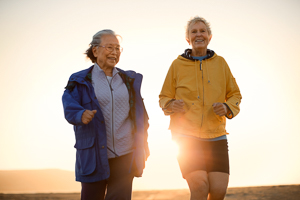Oncology Patient Education
Our Health Library information does not replace the advice of a doctor. Please be advised that this information is made available to assist our patients to learn more about their health. Our providers may not see and/or treat all topics found herein.
Topic Contents
Physical Activity as You Get Older
Overview

It's never too late to start getting active. Being fit is important for everyone. You can benefit from physical activity even if you already have conditions such as arthritis or heart disease. Being more active will help you feel better. And it may even help you live longer.
If you haven't been active for a long time, you may have no idea where to start. The important thing is to take that first step—and make that first step a small one.
- Talk with your doctor if you're worried about how exercise might affect your health.
If you're already active, ask your doctor if there is anything you should change to stay safe as your body and health change.
- Start slow.
If you have been inactive for years, start with about 5 to 10 minutes of activity at a time. Then increase your time as you get more comfortable with the activity.
- Try to improve only a little bit at a time.
Pick one area for improvement first. Set your personal goal in that area. Meet that goal before you try another area.
- Don't overdo it!
Some minor soreness or stiffness is to be expected at first. But pain is a warning sign to stop.
Benefits of physical activity
Many people are less active as they age. But staying active—or getting active, if you aren't already—has real benefits.
- Aerobic exercise strengthens your heart.
- It improves your health and can give you more energy to do the things you like to do. Some examples of aerobic exercise are brisk walking and swimming.
- Strengthening exercises can help you maintain muscle and strengthen bones.
- Strengthening exercises also help protect knees and other joints. These exercises include resistance training, such as lifting weights.
- Flexibility and stretching can help make everyday tasks easier.
- Stretching lets you move your muscles and joints through a full range of motion. This helps increase flexibility. When you stay flexible, regular physical activity and daily tasks, such as tying shoelaces or reaching to a shelf, feel easier. Dancing and yoga are examples of activities that can help you maintain or improve flexibility.
- Balance exercises may help you avoid falls.
- When combined with strengthening exercises, flexibility exercises, and walking, balance exercises can help reduce the risk of falls. Yoga and Tai chi often include balance exercises.
Activity that includes aerobic, strengthening, flexibility, and balance exercises has health benefits for older adults. It can:
- Improve blood pressure.
- Improve heart failure symptoms and shorten hospital stays.
- Improve cholesterol.
- Help keep postmenopausal people from losing bone density.
- Help joints work better and have less pain with osteoarthritis.
- Improve sleep and reduce fatigue.
- Help your brain work better and improve short-term memory.
- Lower the risk of some cancers.
- Lower the risk of:
- Hip and spinal fractures.
- Falling.
- Coronary artery disease.
- Diabetes.
- Depression.
- Obesity.
Physical activity doesn't have to be hard or intense. Older adults can get lots of health benefits with a moderate amount of physical activity. This can be done in longer sessions of moderately intense activities (such as walking). Or you can do shorter sessions of more vigorous activities (such as fast walking or stair-walking).
Staying safe
It's important to know when to stop exercising and when to call your doctor. When you exercise, it's normal to have some minor muscle and joint soreness. But other signs may point to something more serious. Work with your doctor to know when to stop and when to call.
Related Information
Credits
Current as of: July 31, 2024
Author: Ignite Healthwise, LLC Staff
Clinical Review Board
All Healthwise education is reviewed by a team that includes physicians, nurses, advanced practitioners, registered dieticians, and other healthcare professionals.
Current as of: July 31, 2024
Author: Ignite Healthwise, LLC Staff
Clinical Review Board
All Healthwise education is reviewed by a team that includes physicians, nurses, advanced practitioners, registered dieticians, and other healthcare professionals.
This information does not replace the advice of a doctor. Ignite Healthwise, LLC disclaims any warranty or liability for your use of this information. Your use of this information means that you agree to the Terms of Use and Privacy Policy. Learn how we develop our content.
To learn more about Ignite Healthwise, LLC, visit webmdignite.com.
© 2024 Ignite Healthwise, LLC. Healthwise, Healthwise for every health decision, and the Healthwise logo are trademarks of Ignite Healthwise, LLC.



